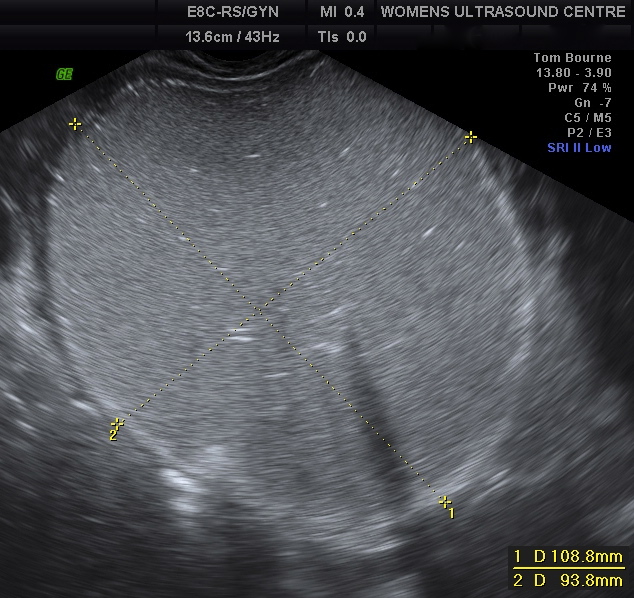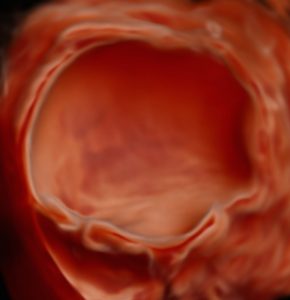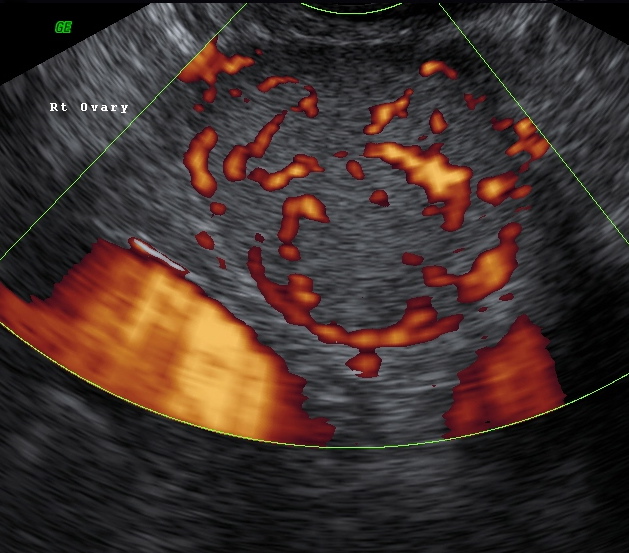 When people think of a “cyst” they are often alarmed and think there must be a major problem. It is important to remember that a cyst is simply a fluid filled sac and does not in itself indicate a specific diagnosis. In younger women by far the majority of ovarian cysts are related to ovarian function (physiological). For example if ovulation does not occur, a small cyst may develop. In these circumstances if such a cyst is seen on ultrasound, a repeat examination in six weeks is advised to check for resolution. These cysts that relate to ovarian function can cause pain and on occasion treatment is required.
When people think of a “cyst” they are often alarmed and think there must be a major problem. It is important to remember that a cyst is simply a fluid filled sac and does not in itself indicate a specific diagnosis. In younger women by far the majority of ovarian cysts are related to ovarian function (physiological). For example if ovulation does not occur, a small cyst may develop. In these circumstances if such a cyst is seen on ultrasound, a repeat examination in six weeks is advised to check for resolution. These cysts that relate to ovarian function can cause pain and on occasion treatment is required.
The ovary is made up of different types of cells that have different roles. There are many types of cysts that are benign growths, the different nature of these cysts reflect the cell type that they originate from. In young women probably the most common cysts that we see are benign cystic teratoma’s (dermoid cysts) or endometrioma’s. Again just because a cyst is present does not mean it has to be removed – however surgery is usually recommended in these cases unless the cyst is very small. These growths of the ovary can cause pain and occasionally they may cause the ovary to become twisted. The likelihood of these complications occurring is thought by some to depend on the size of the cyst. It is generally thought that complications are more likely if the cyst is more than 5 cm in largest diameter.
 Towards the menopause and beyond the presence of an ovarian cyst is likely to cause more concern. Although ovarian cancer is in fact a relatively uncommon disease, it becomes more common with increasing age. Again benign cysts are more common. These are characterised by having a smooth internal wall and clear fluid contents. These cysts are called benign cystadenoma’s and they originate from the tissue that covers the ovary (called the epithelium). Unfortunately some ovarian cysts will turn out to be malignant (cancerous) although it must be emphasised that most ovarian cysts are benign.
Towards the menopause and beyond the presence of an ovarian cyst is likely to cause more concern. Although ovarian cancer is in fact a relatively uncommon disease, it becomes more common with increasing age. Again benign cysts are more common. These are characterised by having a smooth internal wall and clear fluid contents. These cysts are called benign cystadenoma’s and they originate from the tissue that covers the ovary (called the epithelium). Unfortunately some ovarian cysts will turn out to be malignant (cancerous) although it must be emphasised that most ovarian cysts are benign.
Diagnosis
Ultrasound is used as the main tool to diagnose ovarian cysts. However a scan should in most cases indicate not only that a cyst exists, but also give an opinion on the type of the cyst that is present. Many common cysts such as teratomas and endometriomas have a characteristic appearance. Nearly all cysts that have a smooth internal capsule and clear contents (called “simple”) are completely benign. Cancers tend to be associated with an irregular internal cyst wall, solid projections of tissue into the cyst cavity and increased vascularity.
Management
In young women many ovarian cysts will resolve spontaneously without intervention. For other cysts a “watch and wait” policy may be adopted – with the cyst being monitored over a period of time.
If intervention is required then for most benign cysts laparoscopic (keyhole) surgery will be possible, although this will not be possible in all cases. Should the cyst be too large or the patient has undergone previous surgery a conventional “open” approach may be needed to remove the cyst.
After the menopause a less conservative approach is often taken and removal of an ovary because of an ovarian cyst is more likely. In the unlikely event that a cyst has features of cancer then surgery should be performed by a sub-specialist trained in gynaecological oncology and any further treatment planned with a multidisciplinary team of specialists.
